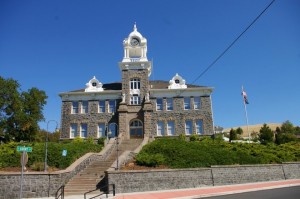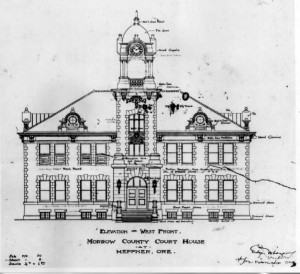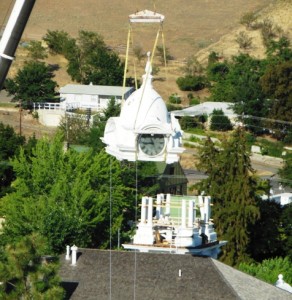
American Courthouses photo archive)
After waiting nearly a year, the historic Morrow County Courthouse in Heppner is complete once again. On June 26, a crowd of eager spectators watched as the courthouse’s domed cupola, which houses an original turn-of-the-century Seth Thomas chiming clock, was hoisted back into place atop the venerable structure’s clock tower.
Built in 1902–03, Morrow County Courthouse is one of the oldest continuously-used courthouses in Oregon. It was listed on the National Register of Historic Places in 1985, and was among the early commissions of prominent Portland architect Edgar M. Lazarus. The courthouse’s design is classically inspired, featuring a cornice around the top of the building and two draped female statues on columns that flank the building’s entrance. Brothers Laurence and Louis Monterastelli created the statues for the building and cut and trimmed the locally quarried dark blue basalt for the exterior. The building’s lighter stone trim was sourced from quarries near Elgin and Baker City.

(image courtesy of Univ. of Oregon Libraries)
The courthouse sits above much of the rest of town, a position that saved it from severe flood damage when the Great Heppner Flood swept through the city in 1903. Just months after County officials began occupying the building, much of Heppner was destroyed and 247 people— nearly a quarter of the city’s population— were killed by the flash flood on Willow Creek, which runs through the center of town. The flood remains Oregon’s deadliest natural disaster, and the second deadliest flash flood in United States history. The courthouse served as temporary shelter for some families displaced by the event.
The need for repairs to the building’s striking clock tower became evident in recent years, with concerns about the long term stability of the cupola and its supporting structure. In 2013, County Public Works officials decided to undertake an extensive restoration. The utmost care was taken to maintain its historic and architectural integrity— many elements in need of replacement were rebuilt as exact replicas. Licensed master clockmaker Gary Kopperud agreed to restore the clock back to its original condition through his clockmaker’s training program at Eastern Oregon Correctional Institution in Pendleton. Inmates at the facility spent months refurbishing the clock, with missing parts (to replace those lost when Morrow County converted the clock to run on electricity about 50 years ago) tracked down as far away as New York.

(photo courtesy of The Association of
Oregon Counties)
Rather than assembling scaffolding and performing the restoration in place, the county determined it could save more than $200,000 by hiring a crane service to remove the entire structure and complete the work on the ground. Once restoration and structural upgrade work was complete, workers guided the elements back into place using a 360-ton crane.
Morrow County Judge Terry Tallman said the investment shows that the county is serious about keeping the courthouse in Heppner for many years to come, and local residents are grateful for the return of the familiar sound of the clock ringing out, every hour on the hour.
For more photos of the restoration, visit the East Oregonian.


